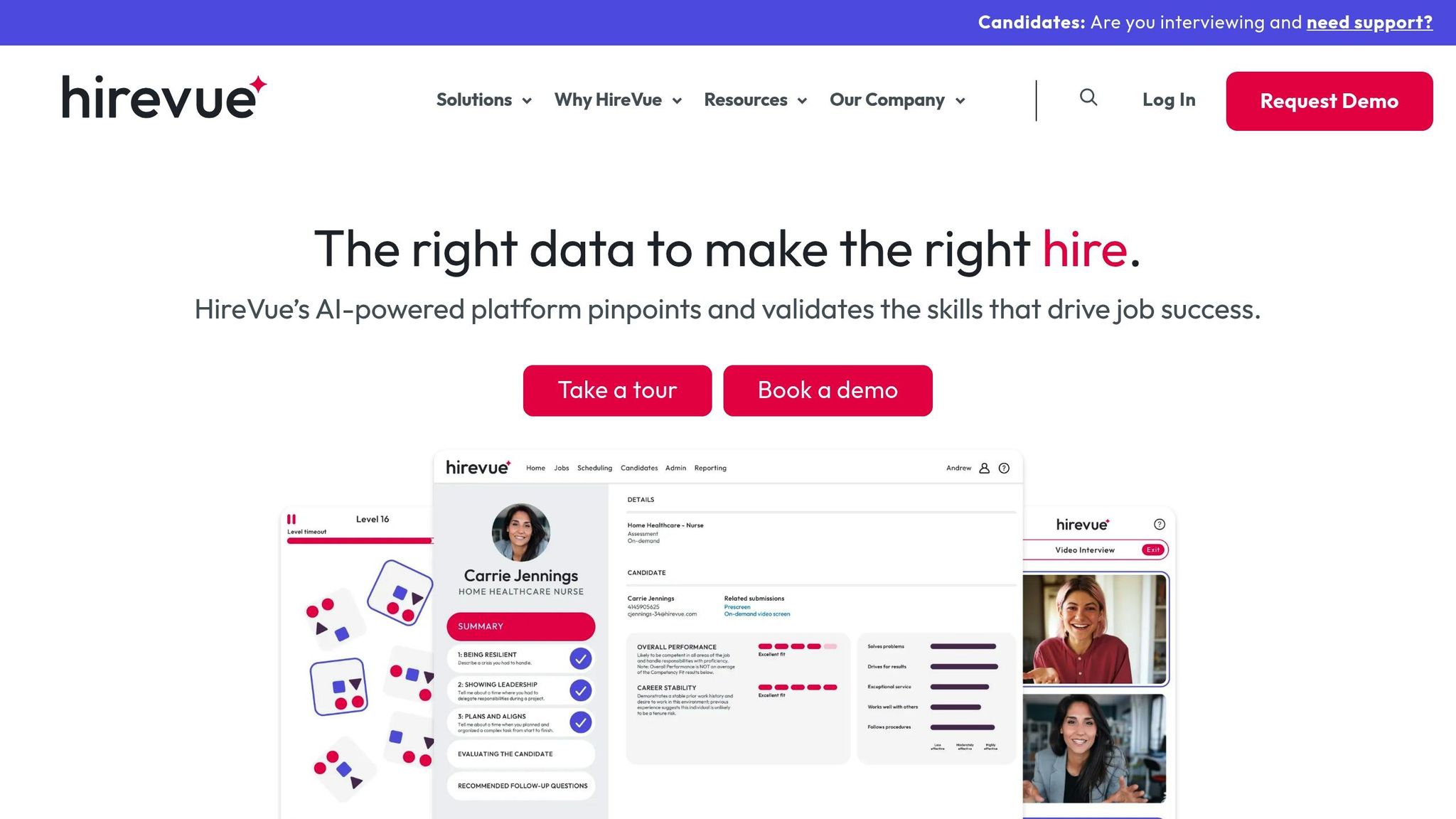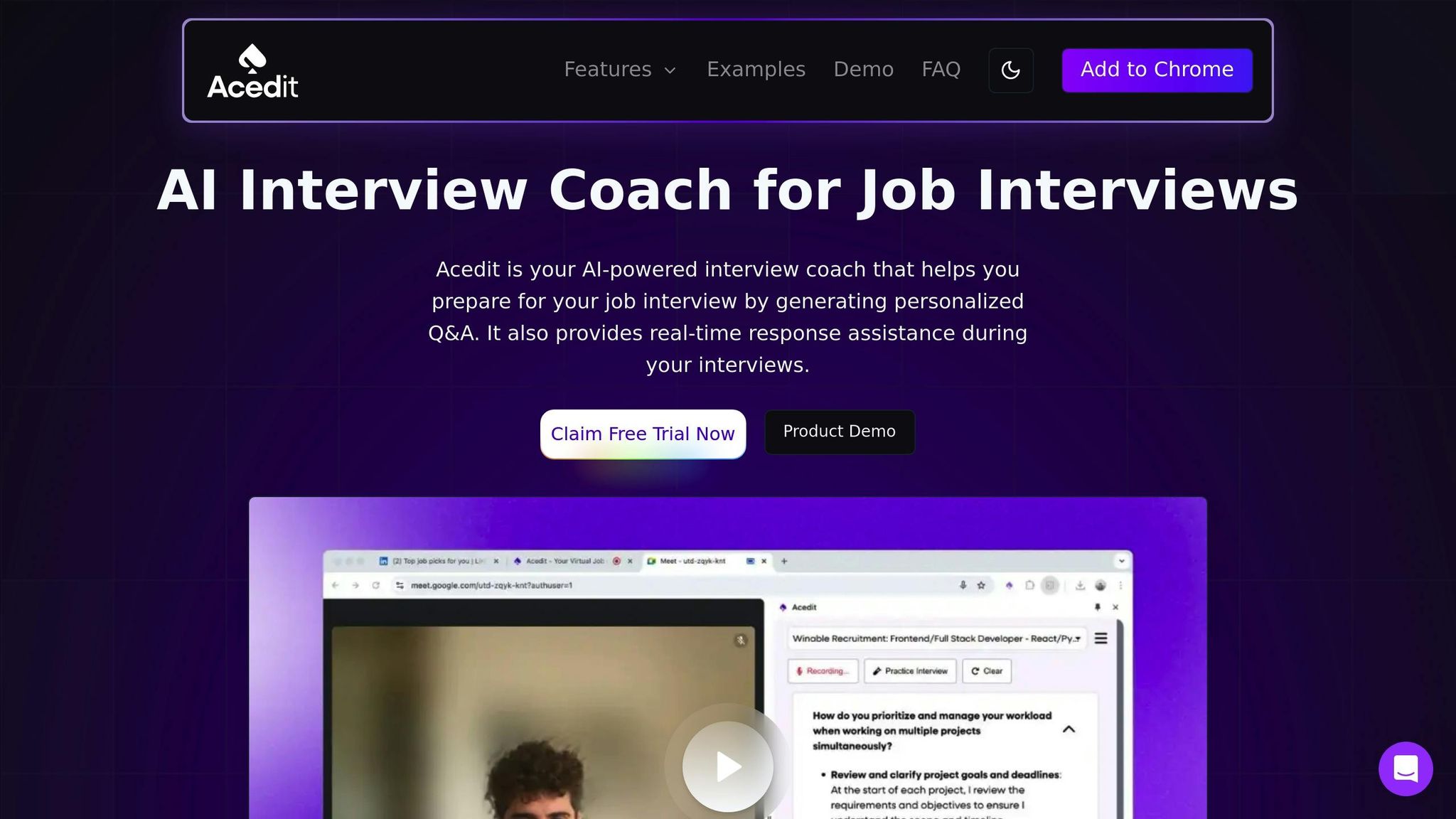How should candidates prepare for better interview timing? AI tools or manual methods?
AI tools like Acedit provide real-time feedback to help candidates improve response timing, track patterns, and align answers with job needs. Manual methods rely on human judgment, offering deeper insights into tone and body language but can be slower and less consistent.
Here’s a quick overview:
- AI Analysis: Fast, consistent, scalable, and cost-effective but may miss subtle communication nuances.
- Manual Analysis: Context-aware and nuanced but time-consuming and subjective.
- Best Approach: Combine AI's speed with human expertise for balanced results.
Quick Comparison:
| Metric | AI Analysis | Manual Analysis |
|---|---|---|
| Speed | Real-time | Slower, detailed reviews |
| Consistency | Uniform results | Varies by evaluator |
| Scalability | Handles large volumes | Limited by evaluator capacity |
| Context Recognition | Basic context focus | Excels at subtle cues |
| Cost | Affordable for high volume | Higher for in-depth evaluations |
For job seekers, AI tools are excellent for practice and timing improvements. For hiring teams, combining both methods ensures thorough and efficient evaluations.
AI Timing Analysis: Core Elements
Main AI Analysis Functions
AI tools bring a new level of precision to interview preparation with real-time features. They analyze speech patterns, track timing, and check how well responses align with job requirements.
Here’s what they do:
- Immediate Question Recognition: Algorithms detect and process interview questions as they are asked.
- Response Timing Analysis: Tracks how long and how fast you answer, offering instant feedback.
- Content Matching: Evaluates your answers to see how closely they align with the job's needs.
Acedit uses these features to help candidates fine-tune their timing and ensure their responses meet job expectations.
Advantages of AI Analysis
AI timing analysis provides consistent, actionable feedback that can transform how candidates approach interviews. Here’s how it helps:
- Continuous Improvement: Learns from your progress and adjusts its suggestions.
- Unlimited Practice: Allows unlimited rehearsals without worrying about schedules.
- Real-Time Feedback: Offers immediate tips during practice to keep your timing on point.
- Data-Driven Insights: Uses patterns from thousands of successful interviews to guide you.
AI Analysis Constraints
While these tools are powerful, they come with some limitations:
- Technical Requirements: Tools like Acedit need the Chrome browser and a stable internet connection.
- Cost: Accessing premium features often requires a subscription or one-time payment.
- Context Challenges: AI may struggle with subtle nuances in human communication or industry-specific timing norms.
Despite these hurdles, when configured correctly, these tools offer immense value. They help candidates set realistic expectations while preparing effectively.
The results speak for themselves: Acedit has helped over 3,000 candidates secure more than 2,500 jobs, with a user satisfaction rate exceeding 97%. These numbers highlight the impact AI timing analysis can have on interview preparation.
How to Ace an AI Video Interview | #Hirevue

Manual Timing Analysis: Core Elements
Manual timing analysis relies on skilled interviewers using basic tools and their own judgment to measure response times. Unlike AI-based methods, this approach depends entirely on human interpretation to evaluate how effective responses are.
Main Manual Analysis Methods
This approach provides insights that automated systems might overlook. By factoring in the context and reacting to real-time interactions, manual analysis can pick up on subtle verbal and non-verbal cues. This allows for a more personalized evaluation of communication styles.
Advantages of Manual Analysis
One of the strengths of manual analysis is its ability to interpret context and adjust to live interactions. It can account for small details in tone, body language, and phrasing, offering a deeper understanding of individual responses.
Manual Analysis Constraints
Despite its strengths, manual analysis has its downsides. It can be subjective, leading to inconsistencies between evaluators. It also requires a lot of time, making it harder to standardize or scale effectively.
sbb-itb-20a3bee
Direct Comparison: AI vs. Manual Analysis
AI and manual analysis each bring their own strengths and challenges to the table.
Performance Metrics Comparison
| Metric | AI Analysis | Manual Analysis |
|---|---|---|
| Processing Speed | Delivers fast, real-time evaluation | Takes more time for thorough reviews |
| Consistency | Produces uniform, automated results | Results can vary by evaluator expertise |
| Scalability | Handles large volumes simultaneously | Limited by individual evaluator capacity |
| Context Recognition | Focuses on keywords and basic context | Excels at understanding subtle details |
| Cost Efficiency | More affordable for high-volume tasks | Higher costs for in-depth evaluations |
| Error Detection | Quickly spots standard timing issues | Better at catching subtle anomalies |
AI analysis stands out for its speed and ability to handle high volumes, making it a great choice for initial screenings or situations where efficiency is key. On the other hand, manual analysis shines in understanding complex situations, capturing nuances like tone, body language, and the intricacies of communication.
The best choice depends on what your organization needs. AI is perfect for streamlining large-scale processes, while manual evaluation is better for roles requiring a deeper, more nuanced understanding of candidates.
Next, we'll look at how combining these methods can improve interview analysis even further.
Combined AI-Manual Approach
Merging AI technology with human expertise brings together the speed of automation and the depth of human judgment.
How AI Supports the Process
AI tools simplify the more time-consuming aspects of analysis, letting interviewers concentrate on more complex evaluations. These tools handle tasks like:
- Real-time monitoring: Tracks response patterns and flags potential issues on the spot.
- Data aggregation: Collects and organizes timing metrics across multiple sessions automatically.
- Pattern recognition: Identifies recurring timing behaviors quickly and efficiently.
By automating these repetitive tasks, AI allows interviewers and candidates to focus on preparation and improvement, creating a more effective workflow.
Example: How Acedit Combines AI and Human Judgment

Acedit is a great example of how AI and human input can work together during interview preparation. Its system uses AI to provide real-time assistance while leaving room for personal judgment and experience. Here's how it works:
| Feature | AI's Role | Human Role |
|---|---|---|
| Question Detection | Recognizes interview questions automatically | Interprets the intent behind them |
| Response Timing | Monitors pacing in real time | Adjusts based on personal style |
| Answer Structure | Suggests a framework for responses | Adds personal experiences |
| Practice Sessions | Gives automated feedback on timing | Self-evaluates and makes adjustments |
This blend of AI-driven precision and human insight helps candidates refine their interview strategies, balancing technology with personal expertise for better results.
Selecting Your Analysis Method
When comparing AI and manual methods, choosing the right approach can make a big difference in interview performance. Here’s a quick guide to help you decide based on candidates' response timing:
| Scenario | Recommended Approach | Key Benefits |
|---|---|---|
| Remote Interviews | AI-Assisted | Real-time question detection and timing feedback |
| Leadership Roles | Combined AI-Manual | Balanced review of technical and interpersonal skills |
| Entry-Level Positions | AI-Powered | Consistent evaluation across large applicant pools |
| Technical Interviews | AI-Enhanced | Structured timing with focus on technical accuracy |
These examples show how your method should fit the interview type and available resources. In today’s hiring landscape, AI tools with real-time capabilities can be game-changers.
How to Choose Based on Your Needs
For job seekers:
- Use AI tools to practice and fine-tune your timing.
- Focus on tailoring responses to match your style.
- Take advantage of real-time feedback during practice sessions.
For hiring teams:
- Use AI for consistent evaluation across candidates.
- Keep human oversight for more nuanced judgments.
- Analyze timing patterns across multiple interviews to spot trends.
If budget is tight, look for tools with flexible pricing. For example, Acedit offers a free plan with basics like AI-assisted interviews and practice Q&A generation. Their premium plan, priced at $45 as a one-time fee, unlocks unlimited advanced features.
"The AI Interview Copilot gave me the confidence I needed to tackle tough questions, and it helped me land a dream job in consultation", says Ethan Brown, who recently secured a consulting role.